HANOI
We traveled to Vietnam from Langkawi, Malaysia. It was a relatively easy trip. We flew from Langkawi to Kuala Lumpur, had a brief layover, then flew from Kuala Lumpur to Hanoi. We were there before sundown.
As we flew in, we both noted the same two characteristics of the city – poor air quality and relatively few high-rise buildings. The air quality was not as bad as we experienced in China, but it was not anything we would want to breathe on a daily basis. And other than a few new hotels, few buildings were more than four stories tall.
Our guide, Doanh, and driver picked us up at the airport, and we headed off to see what we could see in the little remaining daylight. The traffic on the roads was a bit overwhelming for us. We were grateful for our driver, and we decided that we definitely would not drive ourselves in Hanoi. We drove around Hanoi’s Old Quarter and enjoyed the obvious French influence on the architecture of its ageing buildings. The sights, sounds, and smells were all new to us, and we were soaking in as much as we could from inside a car. We were excitedly looking forward to exploring this new and vibrant culture as best we could in our limited time. But for our first day, our mission was to get to our hotel, check in, clean up, and get ready for dinner.
We would stay at the M Hotel in Hanoi – formerly the Gouman. It advertises itself as “Hanoi’s only boutique hotel”, but we never figured out why they call themselves that. There is nothing unique or special about it. This has been a four-star hotel (that is four Asian stars – not the same as four stars in the western world), and it has just been reclassified as a five-star. We think someone was being overly generous. There was nothing specifically wrong with the hotel, but there was nothing specifically nice about it. It was an acceptably clean place to sleep with little else to offer. It was forgettable, but it was fine for us to call home during our stay in Hanoi.
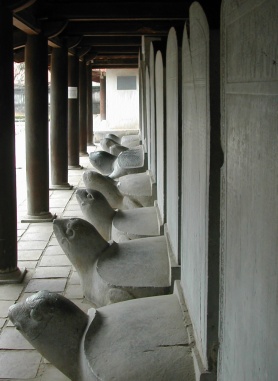
Stone stelae at Temple of Literature
We took a trip way back in time by visiting the Temple of Literature–Van Mieu.
This temple was built in the 11th century by Emperor Ly Thanh Tong and dedicated to Confucius. It was later established as a university for educating Mandarins, and in the 15th century, Emperor Le Thanh Tong ordered the creation of stone stelae honoring those men educated there. The massive stone stelae were each mounted on a stone tortoise, and all 82 remain. The courtyards, reflecting pools, and pavilions reflect traditional Vietnamese architecture, and it is a peaceful respite in the center of this busy city.
Hanoi is a city of much history, and many of its sights are in the Old Quarter. This is the historic heart of Hanoi. It is busy and crowded and full of life. Just walking the streets in the Old Quarter is a cultural experience.
From the Temple of Literature, we jumped a few years forward when we visited Bach Ma Temple. Bach Ma Temple, on the northern edge of the Old Quarter, is the oldest temple in Hanoi. A wonderful legend surrounds this temple. Supposedly Emperor Ly Thai To was trying to build city walls, and they kept collapsing. He prayed at this temple and asked for help. A white horse appeared and guided him to the site where he should and did build the walls that did not collapse. There is a wooden statue of the horse inside the temple.
In the center of the Old Quarter is Hoan Kim Lake – Lake of the Restored Sword. Another legend involving Emperor Ly Thai To is based here. According to this legend, heaven gave the emperor a magic sword with which he drove the Chinese out of Vietnam. However, while boating on the lake, a giant tortoise grabbed the sword and took it to the bottom of the lake. The tortoise ‘restored’ the sword to its rightful owner – heaven. We visited the lake and Ngoc Son Temple which is on a small island in the middle of the lake. This temple has the stuffed remains of a giant tortoise.
We also spent some time browsing around the huge Dong Xuan Market in Hanoi. It covers blocks, and it appears that one could find anything there given enough time. It was busy and lots of fun.
The area to the north and west of the Old Quarter is highly developed. Many of the usual ‘sights’ to see in Hanoi are in this area.
We had already visited the oldest temple in Hanoi (Bach Ma Temple), and now we visited the oldest pagoda. The Tran Quoc Pagoda was constructed in the 6th century during the reign of King Ly Nam De. It was built outside the Phu dyke and later moved to its current location on a peninsula in West Lake. When the pagoda was built it was called Kahi Quoc which means ‘founding the country’. It has also been called An Quoc, Tran Quoc, and Tran Bac. It includes a triple gate, the main pagoda, a sitting room, the ancestor monks’ worshipping chamber, and the tower garden. It is a tall and stunning landmark on West Lake.
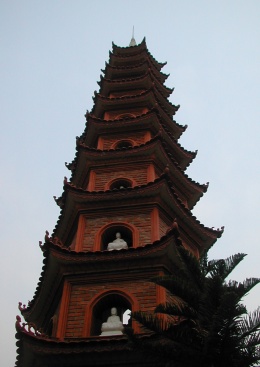
Tran Quoc Pagoda
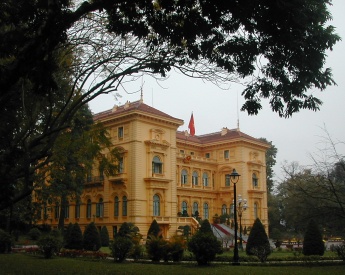
Presidential Palace
Although we both have considerable respect for Ho Chi Minh, we didn’t particularly care to spend our time visiting the Ho Chi Minh Mausoleum Complex. But our guide thought we should go, so we went. We did, however, tell him that we did not want to go in the mausoleum itself to see the 40-year-dead corpse of Ho Chi Minh.
Our first stop was an hour-long wait in the sun to get in to the mausoleum. We probably should have protested a bit louder, but we both sensed that it was important to him that we do this, so we stood in the hot sun for an hour to go in the overly-chilled mausoleum to see Uncle Ho. Neither of us believes that what we saw is Uncle Ho. The lights are low, and guards armed with bayonets stand all around the glass-encased ‘body’, so one cannot get close. However, it appears that they are guarding a wax-like replica of Uncle Ho. Just as well. Looking at a 40-year-dead corpse is not our idea of vacation sightseeing anyways.
Upon emerging from the mausoleum, we again stood in the sun as Doanh gave us an hour-long lecture on Ho Chi Minh. Couldn’t we do this sitting under a shade tree?
We then visited Uncle Ho’s living quarters on the property. He lived here much of the time from 1958 to 1969. It was a simple but charming house built on a small man-made lake. Nice digs.
We also visited the Ho Chi Minh Museum, but we were disappointed in it. It is more of a ‘tribute’ than a museum.
The Presidential Palace is also part of the complex. This was built in 1906 for the governor general of Indochina. It is beautifully maintained, but apparently it is rarely used. We could not enter the palace. We saw it only from the outside.
The One-Pillar Pagoda is also part of the complex. This is a very small pagoda designed to represent a lotus blossom – a bit of a stretch for our imaginations. This pagoda has been rebuilt many times over the years.
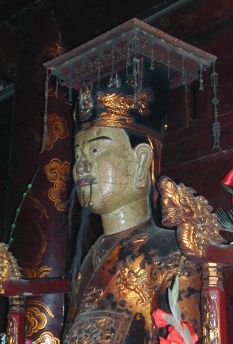
Inside Le Dynasty pagoda
This museum is all that remains of the former Hoa Lo Prison which is better known to Americans as the ‘Hanoi Hilton’. This is where US POWs were kept from 1964 to 1973 during the American-Vietnamese war. The prison was built in 1896 by the French, and it was at one time the largest prison in northern Vietnam. Most exhibits relate to the prison’s longer history of housing Vietnamese during their struggle for independence from France, and it still contains some rather dreary tools of torture and a guillotine used to behead Vietnamese revolutionaries. However, it also has numerous exhibits relating to the years it housed American POWs. Two-thirds of the prison was demolished in 1993 to make way for new buildings; however, this corner has been preserved, and it was a worthwhile place to visit.
We went to see a water puppet show and surprisingly enjoyed it. Water puppetry – roi nuoc – originated in northern Vietnam at least 1,000 years ago when rice farmers used flooded rice paddies as a stage for their wooden puppets. However, now these shows are in small auditoriums. We went to the Thang Long Water Puppet Theater, and the show we saw had seven musicians and ten puppeteers. They put on a 90-minute show with 17 scenes, and it was quite entertaining.

Water Puppets
We spent one great day traveling southwest out of Hanoi. Our guide and driver picked us up early in the morning so we could make the two-hour drive to the Perfume Pagoda. We left the hotel at 0730 – during rush hour traffic – and it was an unforgettable experience. There are a few trucks, many cars, and thousands and thousands of motor scooters. No rules of the road are apparent, but it somehow works. Somehow – we have no idea – these vehicles all share the road with very few accidents, and traffic keeps moving. It was a highly memorable experience!
As we got a ways out of town, the landscape became mile after mile of rice paddies. No land is wasted. There are rice paddies planted on top of cemeteries, and the headstones are just minor obstacles around which they work. There were people in their conical hats working in most of the paddies, and water buffalo were used to plow them. Very picturesque.
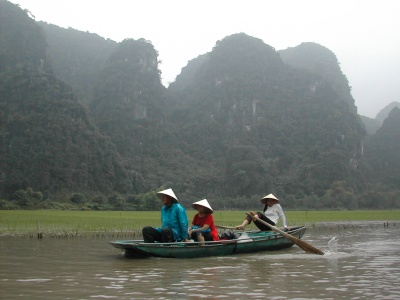
When your hands get tired, use your feet
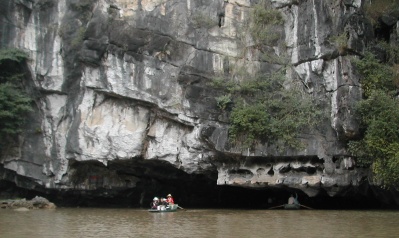
Entering Karst Cave
It was raining lightly when we arrived in My Duc. We walked to Yen Wharf, and we were most surprised to see literally thousands (we were told 5,000) of row boats waiting to take visitors up the Yen Stream to the Perfume Pagoda – Chua Huong. We were told that there are usually only 40 boats there, but it was a local festival time when Buddhists from all over Vietnam travel to the Perfume Pagoda, and boats from all around came to the Yen Stream to make some money. The advantage of it being festival time was that we could expect a strong local influence on our experience there; however, the disadvantage was that we expected it to be crowded. But it wasn’t bad.
A local woman rowed us up the narrow stream for about one hour. It was quiet and beautiful. But our senses were jolted in to overdrive as soon as we disembarked the row boat. We were immediately again immersed in foreign sights, sounds, and smells. And this time, we did not have the insulating layer of a car around us.
We walked by numerous hawker stalls – each with various carcasses of dead animals hanging out in front. Weasel (very big weasel), deer, dog, pig, etc. One can order the kind of meat they want, and it is sliced off the blood-dripping carcass to order. There were also numerous wood-fired ovens that produced some fine looking loaves of bread.
The Perfume Pagoda is actually a complex of 17 pagodas and shrines built in to the karst cliffs of Huong Tich Mountain (Mountain of the Fragrant Traces). This is Vietnam’s largest pagoda complex. The main pagoda is 1 ½ miles up the steep mountainside, but fortunately, a cable car was installed a few years ago. We took the cable car up and walked down.
The pagoda at the top was worth the effort to get to it. It was a large cavern deep within the rocks. And we visited a few lesser pagodas (one built in the 1400s) and shrines as we walked down, but we did not try to see all 17. That would take a few days.
We rowed another hour back down Yen Stream and back to Yen Wharf where our driver was waiting for us. We spent another two hours driving back to Hanoi, and the scenery remained beautiful up to the city’s edge when the traffic engulfed us. But our driver was unflappable, and he got us back to our hotel without a problem. A very interesting day.
We made two trips out of town to the southeast. On one trip, we went only eight miles to Bat Trang – the ceramic village. On another trip, we drove two hours to the southeast through Ninh Binh then on to Hoa Lu and Tam Coc. It was another beautiful drive with mile after mile of emerald green rice paddies. The landscape in this area is also punctuated by countless karst formations – large and small. It is dramatic scenery.
Just eight miles southeast of Hanoi is Bat Trang which is known as the ceramic village. Yes, the village is supported by its ceramic industry. We enjoyed watching the process, and we appreciated many of the pieces we saw, but alas, a boat is not a place for ceramics. We bought nothing.
Hoa Lu, about sixty miles south-southeast of Hanoi, was the capital of Vietnam under the Dinh dynasty (968 – 980) and the Le dynasties (980 – 1009). Little remains of the ancient citadel in Hoa Lu; however, temples of the 1st and 2nd kings of Vietnam have survived. We visited both.
Tam Coc is known for its dramatic karst formations in and around the rice paddies along the Ngo Dong River. In Tam Coc, we hired a rowboat on the river. Like on the Yen Stream, this boat was rowed by one local woman. She rowed us up the shallow and narrow Ngo Dong River and through three caves that have eroded through the limestone over the years. The trip took about one hour each way. The scenery was beautiful.
But it was time to head south. We had spent our allotted time in and around Hanoi in the north. Now we would go to Hue on the central coast.
Follow us to Hue or jump ahead to Saigon or the Mekong Delta and River Or skip the rest of Vietnam and jump ahead to Cambodia.